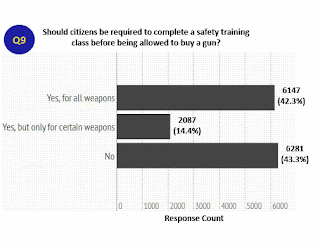officers' perspectives
Top Line Takeaways
Breaking down the results, it's important to note that 70 percent of respondents are field-level law enforcers — those who are face-to-face in the fight against violent crime on a daily basis — not office-bound, non-sworn administrators or perpetually-campaigning elected officials
1.) Virtually all respondents (95 percent) say that a federal ban on
manufacture and sale of ammunition magazines that hold more than 10 rounds
would not reduce violent crime.
2.) The majority of respondents — 71 percent — say a federal
ban on the manufacture and sale of some semi-automatics would have no effect
on reducing violent crime. However, more than 20 percent say any ban would
actually have a negative effect on reducing violent crime. Just over 7
percent took the opposite stance, saying they believe a ban would have a
moderate to significant effect.
3.) About 85 percent of officers say the passage of the White
House’s currently proposed legislation would have a zero or negative effect
on their safety, with just over 10 percent saying it would have a moderate or
significantly positive effect.
4.) Seventy percent of respondents say they have a favorable or very
favorable opinion of some law enforcement leaders’ public statements that
they would not enforce more restrictive gun laws in their jurisdictions.
Similarly, more than 61 percent said they would refuse to enforce such laws
if they themselves were Chief or Sheriff.
5.) More than 28 percent of officers say having more permissive
concealed carry policies for civilians would help most in preventing
large scale shootings in public, followed by more aggressive
institutionalization for mentally ill persons (about 19 percent) and more
armed guards/paid security personnel (about 15 percent). See enlarged image
6.) The overwhelming majority (almost 90 percent) of officers
believe that casualties would be decreased if armed citizens were present at
the onset of an active-shooter incident.
7.) More than 80 percent of respondents support arming school
teachers and administrators who willingly volunteer to train with firearms
and carry one in the course of the job.
8.) More than four in five respondents (81 percent) say that
gun-buyback programs are ineffective in reducing gun violence.
9.) More than half of respondents feel that increased punishment for
obviously illegal gun sales could have a positive impact on reducing gun
violence.
10.) When asked whether citizens should be required to complete a
safety training class before being allowed to buy a gun, about 43 percent of
officers say it should not be required. About 42 percent say it should be
required for all weapons, with the remainder favoring training classes for
certain weapons.
11.) While some officers say gun violence in the United States stems
from violent movies and video games (14 percent), early release and short
sentencing for violent offenders (14 percent) and poor
identification/treatments of mentally-ill individuals (10 percent), the
majority (38 percent) blame a decline in parenting and family values.
Bottom Line Conclusions
Quite clearly, the majority of officers polled oppose the theories brought forth by gun-control advocates who claim that proposed restrictions on weapon capabilities and production would reduce crime.
In fact, many officers responding to this survey seem to feel
that those controls will negatively affect their ability to fight violent
criminals.
Contrary to what the mainstream media and certain politicians
would have us believe, police overwhelmingly favor an armed citizenry, would
like to see more guns in the hands of responsible people, and are skeptical
of any greater restrictions placed on gun purchase, ownership, or
accessibility.
The officers patrolling America’s streets have a deeply-vested
interest — and perhaps the most relevant interest — in making sure that
decisions related to controlling, monitoring, restricting, as well as
supporting and/or prohibiting an armed populace are wise and effective. With
this survey, their voice has been heard.
|
About the author
Doug Wyllie is Editor in Chief of
PoliceOne, responsible for setting the editorial direction of the website and
managing the planned editorial features by our roster of expert writers. In
addition to his editorial and managerial responsibilities, Doug has authored
more than 600 feature articles and tactical tips on a wide range of topics
and trends that affect the law enforcement community. Doug is a member of
International Law Enforcement Educators and Trainers Association (ILEETA),
and an Associate Member of the California Peace Officers' Association. He is
also a member of the Public Safety Writers Association, and is a two-time
(2011 and 2012) Western Publishing Association "Maggie Award"
Finalist in the category of Best Regularly Featured Digital Edition Column.
Even in his "spare" time, he is active in his support for the law
enforcement community, contributing his time and talents toward
police-related charitable events as well as participating in force-on-force
training, search-and-rescue training, and other scenario-based training
designed to prepare cops for the fight they face every day on the street.
Read more articles by PoliceOne Editor in Chief Doug Wyllie by clicking here. Contact Doug Wyllie |




.gif)








No comments:
Post a Comment